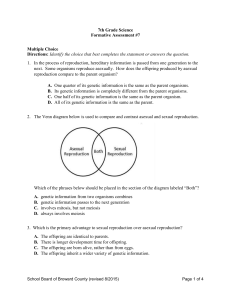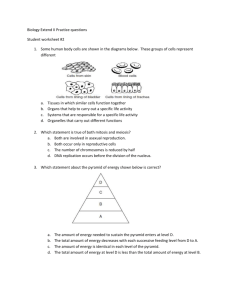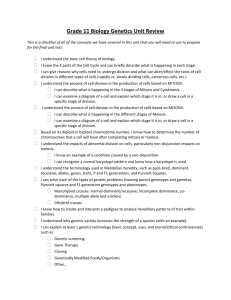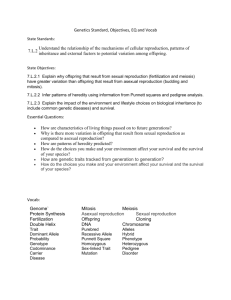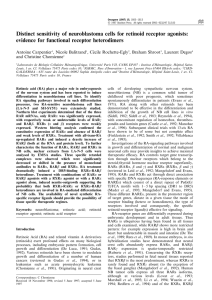G7SC_Test7 - Secondary Science
advertisement
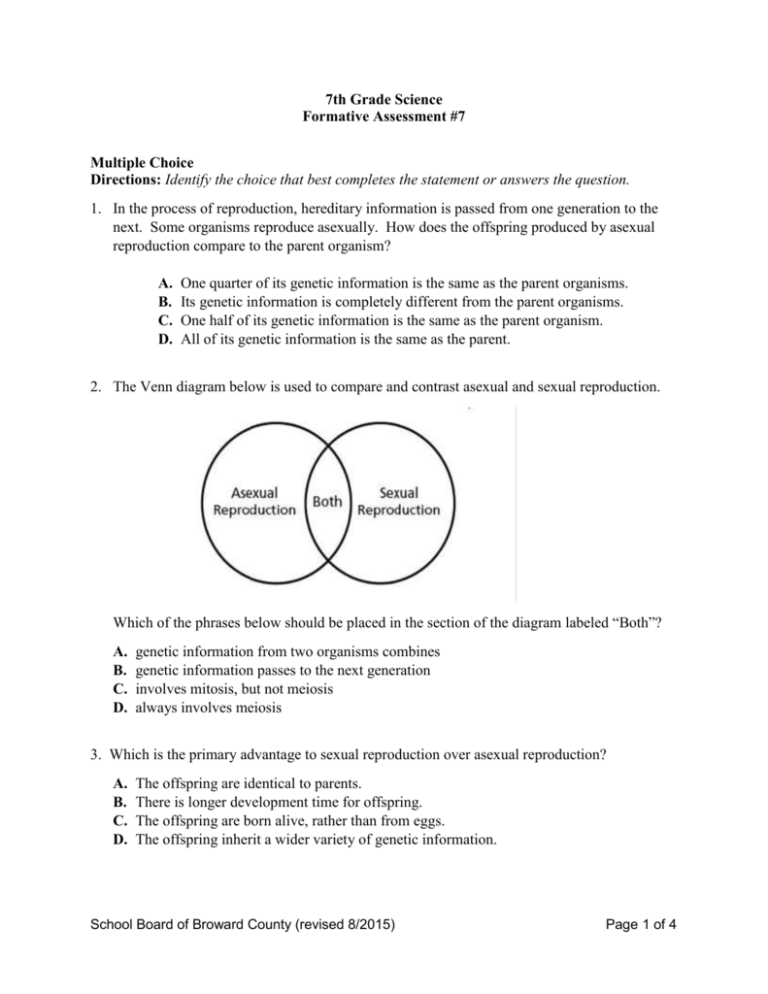
7th Grade Science Formative Assessment #7 Multiple Choice Directions: Identify the choice that best completes the statement or answers the question. 1. In the process of reproduction, hereditary information is passed from one generation to the next. Some organisms reproduce asexually. How does the offspring produced by asexual reproduction compare to the parent organism? A. B. C. D. One quarter of its genetic information is the same as the parent organisms. Its genetic information is completely different from the parent organisms. One half of its genetic information is the same as the parent organism. All of its genetic information is the same as the parent. 2. The Venn diagram below is used to compare and contrast asexual and sexual reproduction. Which of the phrases below should be placed in the section of the diagram labeled “Both”? A. B. C. D. genetic information from two organisms combines genetic information passes to the next generation involves mitosis, but not meiosis always involves meiosis 3. Which is the primary advantage to sexual reproduction over asexual reproduction? A. B. C. D. The offspring are identical to parents. There is longer development time for offspring. The offspring are born alive, rather than from eggs. The offspring inherit a wider variety of genetic information. School Board of Broward County (revised 8/2015) Page 1 of 4 4. A student uses a microscope to observe cells in the root tissue of an onion. He concludes that the cells are reproducing by mitosis. Which hypothesis is supported by his conclusion? A. B. C. D. The root tissue cells all have the same number of chromosomes. The root tissue cells have the same genetic makeup The root tissue cells produce identical gametes. The root tissue cells split to form stem cells. 5. What is a difference between mitosis and meiosis? A. In mitosis, the products are identical to the parent cell, while in meiosis the products are different from the parent cells. B. Mitosis involves separating the chromosomes, while meiosis only involves the cytoplasm of the cell. C. In mitosis, one cell divides into two cells, while in meiosis two cells combine to make one cell. D. Mitosis occurs in all of the cells of plants and animals, while meiosis occurs in bacteria. 6. Spirogyra are green algae that can reproduce sexually. Which of the following identifies reproduction in Spirogyra as sexual reproduction? A. B. C. D. The cells of parent algae have nuclei. Each offspring contains chloroplasts. Several offspring may be produced at once. Genetic material is contributed by two parent cells. 7. The diagram below shows a sea star in various stages of regeneration. What cellular process is directly responsible for this regeneration? A. B. C. D. Mitosis Meiosis Transpiration Respiration School Board of Broward County (revised 8/2015) Page 2 of 4 8. “As humans grow, their bodies change.” Which statement best explains how humans grow? A. B. C. D. Cells increase in size. Cells form a cell wall. Cells undergo cell division. Cells merge to become larger. 9. Roses produced asexually from cuttings are genetically identical to the parent roses. Roses grown from sexually produced seeds may look different from either parent. Which statement is best supported by this information? A. B. C. D. Sexually produced plants are a new species. Sexual reproduction produces more variation in plants. Asexual reproduction helps plants adapt to different environments. Asexually produced plants are prettier than sexually produced plants. 10. Use the information and diagrams below to answer the following question(s). Astrammina rara is a unicellular organism that is several millimeters long. This organism lives on the ocean floor of Antarctica in an area called Explorer’s Cove. Astrammina rara builds a shell by cementing grains of sand from the ocean floor together. The organism either absorbs nutrients from the water or eats other organisms on the ocean floor. The offspring of Astrammina rara have genes identical to the parent. Below is a diagram of an Astrammina rara and a map showing where the organism lives. Asexual reproduction by Astrammina rara A. B. C. D. involves an egg and a sperm requires a male and a female reduces the variation in the offspring increases the variation in the offspring School Board of Broward County (revised 8/2015) Page 3 of 4 7th Grade Science Formative Assessment #7 Answer Key Answer 1. 2. 3. 4. 5. 6. 7. 8. 9. 10. Benchmark SC.7.L.16.3 SC.7.L.16.3 SC.7.L.16.3 SC.7.L.16.3 SC.7.L.16.3 SC.7.L.16.3 SC.7.L.16.3 SC.7.L.16.3 SC.7.L.16.3 SC.7.L.16.3 School Board of Broward County (revised 8/2015) Correct Answer D B D A A D A C B C DOK 2 2 2 2 2 2 2 2 2 2 Page 4 of 4
